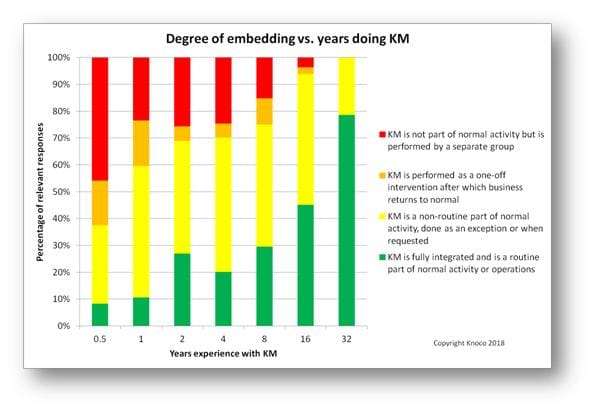5 ways in which KM can become embedded
There are 5 ways in which KM can be embedded in an organisation. Some of these are more common than others, and to fully embed KM into an organisational management system can take over a decade.
I often have people ask me what “embedding” Knowledge Management actually means, and how you do it. Embedding Knowledge Management means making part of the normal work process, rather than an add-on. You do this in five ways, listed below in the order of most common application, as shown in the graph above. (This graph shows the percentage of the respondents who answered this question, who said they had embedded KM in each of the ways listed. The different coloured bars represent respondents from KM programs of different levels of maturity.)
1. You change the technology suite so that Knowledge Management tools are available, and used, as part of the working toolkit, and linked into the existing work tools. While email remains the number one work tool for many people, then link your KM tools into this, rather than requiring people to acquire a new habit. New habits can develop later, when KM becomes part of natural behaviour.
2. You change the Organigram to include Knowledge Management roles and accountabilities. You introduce new roles where needed (lesson teams for example, leaders and coordinators for the big Communities of practice, Practice Owners and so on), and change some of the accountabilities of existing roles. The most senior experts, for example, need clear KM accountabilities, as described here. You need to change their job descriptions, so that they are held accountable for stewardship of the company knowledge. Then you measure and reward people against their performance in these roles, and against these accountabilities, just as you measure and reward them against any other component of their job.
3. You change the high level processes and activities, embedding Knowledge Management processes and activities into the work cycles (using the principles of Learning Before, During and After). Change the project requirements, to include mandatory processes for capture of knowledge at the end of the project or after key milestones, and mandatory processes for reviewing past knowledge at the start of the project. Change the rules for project sanction, so a project gets no money if it hasn’t done any learning.
4. You change the behaviours through peer pressures and through management expectation.
5. You change the governance system to include KM. Write it into the policies. Write it into the way people are rewarded. Change the reporting requirements, the HR appraisal mechanism, change the incentive scheme to reward collaboration and discourage competition. This is the least common embedding approach, but it needs to be done eventually.
These changes should embed KM as part of the way people work, and so make KM part of everyone’s job. Once this is the case, you can claim KM is embedded and fully mature, as shown below.
 |
| The degree of embedding KM into normal activity, vs KM maturity. Results from Knoco 2014 and 2017 surveys |
However this takes time. The chart below shows how this level of embedding varies with the length of time organisations have been doing KM. Even after 16 years working with KM, only half the organisations claim KM is fully integrated and routine, rather than a non-routine activity.
 |


Leave a Reply